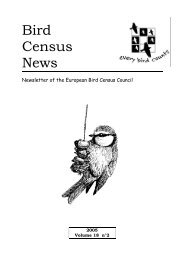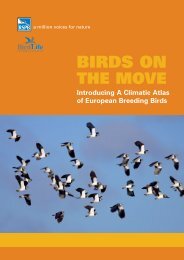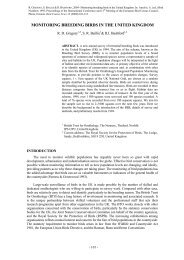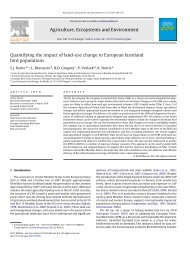The State of Europe's Common Birds 2008 - European Bird Census ...
The State of Europe's Common Birds 2008 - European Bird Census ...
The State of Europe's Common Birds 2008 - European Bird Census ...
Create successful ePaper yourself
Turn your PDF publications into a flip-book with our unique Google optimized e-Paper software.
<strong>The</strong> <strong>State</strong> <strong>of</strong> Europe’s <strong>Common</strong> <strong><strong>Bird</strong>s</strong> <strong>2008</strong>Photo by D. Jirovský (wildbirdphoto.eu)Both papers represented a milestonein reference to PECBMS, mostly asa source <strong>of</strong> information about themethods used to calculate speciesindices and indicators.Another paper, published quiterecently (Gregory et al. <strong>2008</strong>), usesexamples from the UK and Europe toillustrate the state <strong>of</strong> play regardingthe use <strong>of</strong> birds as indicators. <strong>The</strong> UKexperience provides an excellentexample <strong>of</strong> turning scientific data intopolicy measures in natureconservation, which has subsequentlybeen followed by other countries. Alsoat <strong>European</strong> level, the common birdindicators proved to be successful interms <strong>of</strong> use in policy and in fact theyrepresent one <strong>of</strong> very few fullyoperational biodiversity indicators inEurope.<strong>The</strong> Great Reed-warbler Acrocephalusarundinaceus is expected to benefit from climatechange (Gregory et al. 2009). In Poland, it hasalready been shown to be adapting well by shiftingits laying dates, probably to optimise foodresources (Dyrcz and Halupka 2009).from national or regional breeding birdmonitoring schemes can be analysed,supranational species indices can be generatedand multi-species indicators can be calculated byaveraging the resulting indices. <strong>The</strong> paper showedhow data collated by skilled volunteers and bymethods and survey designs that differ slightlybetween countries can be combined to producerelevant multi-national results. It also describedhow and why national species indices need to beweighted by population size in order to producerelevant supra-national figures. <strong>The</strong> paper alsoshowed that common farmland birds in Europehave declined steeply since 1980, and thatevidence elsewhere shows that the main driver <strong>of</strong>farmland bird declines is agriculturalintensification.<strong>The</strong> PECBMS <strong>European</strong> data werealso used for explorative analysis <strong>of</strong>species trends, particularly <strong>of</strong> forestspecies (Gregory et al. 2007). This showed thatsince 1980, forest specialists have declinedmore than forest generalists, but trendsdiffered regionally, and interestingly forestspecies in Central and Eastern Europe haveshown stability or even increased. Anindependent study demonstrated that forestspecialists have increased in the CzechRepublic, most likely as a result <strong>of</strong> increasingforest coverage and age (Reif et al. 2007). At<strong>European</strong> level, among common forest birds,long-distance migrants and residents onaverage declined most strongly, whereas shortdistancemigrants were largely stable, or evenincreased. <strong>The</strong>re was some evidence to suggestthat ground- or low-nesting species declinedmore strongly on average, as did forest birdswith invertebrate diets. It also appeared thatin a small number <strong>of</strong> species, year-to-yearvariation in abundance can be influenced bycold winters. However, much more researchneeds to be done to understand trends <strong>of</strong>forest bird species and their driving forces.22






